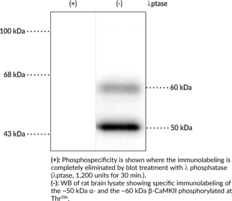Cayman
Showing 13351–13500 of 45550 results
-
Brand:CaymanSKU:24783 - 10 mg
Available on backorder
Brand:CaymanSKU:24783 - 50 mgAvailable on backorder
CALXGLUK is a calixarene detergent that can be used to solubilize membrane proteins.{41704} It has a critical micelle concentration (CMC) of 0.025 mM. CALXGLUK has been used to solubilize a membrane GPCR (MP-A) and a membrane transporter (MP-B) from yeast alone and in combination with Triton X-100 (Item No. 600217) and digitonin (Item No. 14952).
Brand:CaymanSKU:24784 - 10 mgAvailable on backorder
CALXGLUK is a calixarene detergent that can be used to solubilize membrane proteins.{41704} It has a critical micelle concentration (CMC) of 0.025 mM. CALXGLUK has been used to solubilize a membrane GPCR (MP-A) and a membrane transporter (MP-B) from yeast alone and in combination with Triton X-100 (Item No. 600217) and digitonin (Item No. 14952).
Brand:CaymanSKU:24784 - 100 mgAvailable on backorder
CALXGLUK is a calixarene detergent that can be used to solubilize membrane proteins.{41704} It has a critical micelle concentration (CMC) of 0.025 mM. CALXGLUK has been used to solubilize a membrane GPCR (MP-A) and a membrane transporter (MP-B) from yeast alone and in combination with Triton X-100 (Item No. 600217) and digitonin (Item No. 14952).
Brand:CaymanSKU:24784 - 50 mgAvailable on backorder
Calycosin is an isoflavone and phytoestrogen with diverse biological activities.{41872,41873,41874,43143,41875,41876} It is an estrogen receptor (ER) partial agonist that inhibits 17β-estradiol binding to ERα and ERβ (IC50s = 83.14 and 40.38 μM, respectively).{41872} Calycosin induces tube formation by human umbilical vein endothelial cells (HUVECs) in a Matrigel™ assay and angiogenesis in zebrafish via activation of ERs and ERK1/2. It has antiplasmodial and antiprotozoal activities, reducing the growth of the poW and Dd2 strains of P. falciparum (IC50s = 4.2 and 9.8 μg/ml, respectively) and exhibiting selective toxicity for T. brucei brucei over Vero cells (IC50s = 12.7 and 159 μM, respectively).{41873,41874} Calycosin scavenges 2,2-diphenyl-1-picrylhydrazyl (DPPH; Item No. 14805) free radicals in a cell-free assay and inhibits xanthine/xanthine oxidase-induced toxicity in PC12 cells (EC50 = 50 ng/ml).{43143} In vivo, calycosin (12.5 and 25 mg/kg) reduces alanine aminotransferase (ALT) and aspartate aminotransferase (AST) activity, triglyceride accumulation, and hepatic fibrosis in a mouse model of non-alcoholic steatohepatitis (NASH).{41875} It also decreases infarct volume and brain edema in a rat model of focal cerebral ischemia and reperfusion injury.{41876}
Brand:CaymanSKU:25091 - 10 mgAvailable on backorder
Calycosin is an isoflavone and phytoestrogen with diverse biological activities.{41872,41873,41874,43143,41875,41876} It is an estrogen receptor (ER) partial agonist that inhibits 17β-estradiol binding to ERα and ERβ (IC50s = 83.14 and 40.38 μM, respectively).{41872} Calycosin induces tube formation by human umbilical vein endothelial cells (HUVECs) in a Matrigel™ assay and angiogenesis in zebrafish via activation of ERs and ERK1/2. It has antiplasmodial and antiprotozoal activities, reducing the growth of the poW and Dd2 strains of P. falciparum (IC50s = 4.2 and 9.8 μg/ml, respectively) and exhibiting selective toxicity for T. brucei brucei over Vero cells (IC50s = 12.7 and 159 μM, respectively).{41873,41874} Calycosin scavenges 2,2-diphenyl-1-picrylhydrazyl (DPPH; Item No. 14805) free radicals in a cell-free assay and inhibits xanthine/xanthine oxidase-induced toxicity in PC12 cells (EC50 = 50 ng/ml).{43143} In vivo, calycosin (12.5 and 25 mg/kg) reduces alanine aminotransferase (ALT) and aspartate aminotransferase (AST) activity, triglyceride accumulation, and hepatic fibrosis in a mouse model of non-alcoholic steatohepatitis (NASH).{41875} It also decreases infarct volume and brain edema in a rat model of focal cerebral ischemia and reperfusion injury.{41876}
Brand:CaymanSKU:25091 - 25 mgAvailable on backorder
Calycosin is an isoflavone and phytoestrogen with diverse biological activities.{41872,41873,41874,43143,41875,41876} It is an estrogen receptor (ER) partial agonist that inhibits 17β-estradiol binding to ERα and ERβ (IC50s = 83.14 and 40.38 μM, respectively).{41872} Calycosin induces tube formation by human umbilical vein endothelial cells (HUVECs) in a Matrigel™ assay and angiogenesis in zebrafish via activation of ERs and ERK1/2. It has antiplasmodial and antiprotozoal activities, reducing the growth of the poW and Dd2 strains of P. falciparum (IC50s = 4.2 and 9.8 μg/ml, respectively) and exhibiting selective toxicity for T. brucei brucei over Vero cells (IC50s = 12.7 and 159 μM, respectively).{41873,41874} Calycosin scavenges 2,2-diphenyl-1-picrylhydrazyl (DPPH; Item No. 14805) free radicals in a cell-free assay and inhibits xanthine/xanthine oxidase-induced toxicity in PC12 cells (EC50 = 50 ng/ml).{43143} In vivo, calycosin (12.5 and 25 mg/kg) reduces alanine aminotransferase (ALT) and aspartate aminotransferase (AST) activity, triglyceride accumulation, and hepatic fibrosis in a mouse model of non-alcoholic steatohepatitis (NASH).{41875} It also decreases infarct volume and brain edema in a rat model of focal cerebral ischemia and reperfusion injury.{41876}
Brand:CaymanSKU:25091 - 5 mgAvailable on backorder
Calycosin is an isoflavone and phytoestrogen with diverse biological activities.{41872,41873,41874,43143,41875,41876} It is an estrogen receptor (ER) partial agonist that inhibits 17β-estradiol binding to ERα and ERβ (IC50s = 83.14 and 40.38 μM, respectively).{41872} Calycosin induces tube formation by human umbilical vein endothelial cells (HUVECs) in a Matrigel™ assay and angiogenesis in zebrafish via activation of ERs and ERK1/2. It has antiplasmodial and antiprotozoal activities, reducing the growth of the poW and Dd2 strains of P. falciparum (IC50s = 4.2 and 9.8 μg/ml, respectively) and exhibiting selective toxicity for T. brucei brucei over Vero cells (IC50s = 12.7 and 159 μM, respectively).{41873,41874} Calycosin scavenges 2,2-diphenyl-1-picrylhydrazyl (DPPH; Item No. 14805) free radicals in a cell-free assay and inhibits xanthine/xanthine oxidase-induced toxicity in PC12 cells (EC50 = 50 ng/ml).{43143} In vivo, calycosin (12.5 and 25 mg/kg) reduces alanine aminotransferase (ALT) and aspartate aminotransferase (AST) activity, triglyceride accumulation, and hepatic fibrosis in a mouse model of non-alcoholic steatohepatitis (NASH).{41875} It also decreases infarct volume and brain edema in a rat model of focal cerebral ischemia and reperfusion injury.{41876}
Brand:CaymanSKU:25091 - 50 mgAvailable on backorder
Calycosin 7-O-β-D-glucoside is an isoflavone glycoside that has been isolated from A. mongholicus and A. membranaceus and has antioxidant, anti-inflammatory, and neuroprotective biological activities.{43143,43144,43145} It scavenges 34.5% of generated 2,2-diphenyl-1-picrylhydrazyl (DPPH; Item No. 14805) radicals compared to a vehicle control when used at a concentration of 100 μg/ml in a cell-free assay.{43143} Calycosin 7-O-β-D-glucoside (10 μg/ml) inhibits cytotoxicity, intracellular reactive oxygen species (ROS) production, and cytoskeletal defects induced by LPS in human umbilical vein endothelial cells (HUVECs).{43144} In vivo, calycosin 7-O-β-D-glucoside (26.8 mg/kg) reduces brain infarct volume in a rat model of ischemia-reperfusion injury induced by middle cerebral artery occlusion (MCAO).{43145}
Brand:CaymanSKU:25095 - 1 mgAvailable on backorder
Calycosin 7-O-β-D-glucoside is an isoflavone glycoside that has been isolated from A. mongholicus and A. membranaceus and has antioxidant, anti-inflammatory, and neuroprotective biological activities.{43143,43144,43145} It scavenges 34.5% of generated 2,2-diphenyl-1-picrylhydrazyl (DPPH; Item No. 14805) radicals compared to a vehicle control when used at a concentration of 100 μg/ml in a cell-free assay.{43143} Calycosin 7-O-β-D-glucoside (10 μg/ml) inhibits cytotoxicity, intracellular reactive oxygen species (ROS) production, and cytoskeletal defects induced by LPS in human umbilical vein endothelial cells (HUVECs).{43144} In vivo, calycosin 7-O-β-D-glucoside (26.8 mg/kg) reduces brain infarct volume in a rat model of ischemia-reperfusion injury induced by middle cerebral artery occlusion (MCAO).{43145}
Brand:CaymanSKU:25095 - 10 mgAvailable on backorder
Calycosin 7-O-β-D-glucoside is an isoflavone glycoside that has been isolated from A. mongholicus and A. membranaceus and has antioxidant, anti-inflammatory, and neuroprotective biological activities.{43143,43144,43145} It scavenges 34.5% of generated 2,2-diphenyl-1-picrylhydrazyl (DPPH; Item No. 14805) radicals compared to a vehicle control when used at a concentration of 100 μg/ml in a cell-free assay.{43143} Calycosin 7-O-β-D-glucoside (10 μg/ml) inhibits cytotoxicity, intracellular reactive oxygen species (ROS) production, and cytoskeletal defects induced by LPS in human umbilical vein endothelial cells (HUVECs).{43144} In vivo, calycosin 7-O-β-D-glucoside (26.8 mg/kg) reduces brain infarct volume in a rat model of ischemia-reperfusion injury induced by middle cerebral artery occlusion (MCAO).{43145}
Brand:CaymanSKU:25095 - 25 mgAvailable on backorder
Calycosin 7-O-β-D-glucoside is an isoflavone glycoside that has been isolated from A. mongholicus and A. membranaceus and has antioxidant, anti-inflammatory, and neuroprotective biological activities.{43143,43144,43145} It scavenges 34.5% of generated 2,2-diphenyl-1-picrylhydrazyl (DPPH; Item No. 14805) radicals compared to a vehicle control when used at a concentration of 100 μg/ml in a cell-free assay.{43143} Calycosin 7-O-β-D-glucoside (10 μg/ml) inhibits cytotoxicity, intracellular reactive oxygen species (ROS) production, and cytoskeletal defects induced by LPS in human umbilical vein endothelial cells (HUVECs).{43144} In vivo, calycosin 7-O-β-D-glucoside (26.8 mg/kg) reduces brain infarct volume in a rat model of ischemia-reperfusion injury induced by middle cerebral artery occlusion (MCAO).{43145}
Brand:CaymanSKU:25095 - 5 mgAvailable on backorder
Calyculin A is a natural, cell-permeable inhibitor of the serine-threonine protein phosphatases (PP) PP1 and PP2A (IC50s = 0.3-0.7 and 0.5-1 nM, respectively).{32313,21678,32314} It is without significant effect against PP2B, PP2C, and PP4.{21678} Through its effects on PP1 and PP2A, calyculin A has been shown to either promote or inhibit cancer cell growth in tumor cell lines and animal models.{32312,18481}
Brand:CaymanSKU:-Available on backorder
Calyculin A is a natural, cell-permeable inhibitor of the serine-threonine protein phosphatases (PP) PP1 and PP2A (IC50s = 0.3-0.7 and 0.5-1 nM, respectively).{32313,21678,32314} It is without significant effect against PP2B, PP2C, and PP4.{21678} Through its effects on PP1 and PP2A, calyculin A has been shown to either promote or inhibit cancer cell growth in tumor cell lines and animal models.{32312,18481}
Brand:CaymanSKU:-Available on backorder
Camalexin is an alkaloid released by plants of the Brassicaceae family in response to pathogen infection.{35038} In addition to antimicrobial properties and a role in plant defense, camalexin exhibits antiproliferative activity in vitro against various cancer cell lines.{35039,35040,35041,35042} Camalexin is active against HeLa, Jurkat, MDA-MB-231, and CEM cancer cell lines (IC50s = 50.0, 46.2, 77.7, and 67.6 μM, respectively), but it is also toxic to primary human umbilical vein endothelial cells (HUVEC; (IC50 = 74.0 μM).{35040} Camalexin induces apoptosis in Jurkat cells by increasing reactive oxygen species (ROS) levels and activating caspase-8 and caspase-9.{35039} In human prostate cancer cell lines, camalexin (25 μM) is more active against aggressive lines and increases ROS levels and apoptosis via cathepsin D relocation from lysosomes to the cytosol.{35042,35043}
Brand:CaymanSKU:21971 -Out of stock
Camalexin is an alkaloid released by plants of the Brassicaceae family in response to pathogen infection.{35038} In addition to antimicrobial properties and a role in plant defense, camalexin exhibits antiproliferative activity in vitro against various cancer cell lines.{35039,35040,35041,35042} Camalexin is active against HeLa, Jurkat, MDA-MB-231, and CEM cancer cell lines (IC50s = 50.0, 46.2, 77.7, and 67.6 μM, respectively), but it is also toxic to primary human umbilical vein endothelial cells (HUVEC; (IC50 = 74.0 μM).{35040} Camalexin induces apoptosis in Jurkat cells by increasing reactive oxygen species (ROS) levels and activating caspase-8 and caspase-9.{35039} In human prostate cancer cell lines, camalexin (25 μM) is more active against aggressive lines and increases ROS levels and apoptosis via cathepsin D relocation from lysosomes to the cytosol.{35042,35043}
Brand:CaymanSKU:21971 -Out of stock
Camalexin is an alkaloid released by plants of the Brassicaceae family in response to pathogen infection.{35038} In addition to antimicrobial properties and a role in plant defense, camalexin exhibits antiproliferative activity in vitro against various cancer cell lines.{35039,35040,35041,35042} Camalexin is active against HeLa, Jurkat, MDA-MB-231, and CEM cancer cell lines (IC50s = 50.0, 46.2, 77.7, and 67.6 μM, respectively), but it is also toxic to primary human umbilical vein endothelial cells (HUVEC; (IC50 = 74.0 μM).{35040} Camalexin induces apoptosis in Jurkat cells by increasing reactive oxygen species (ROS) levels and activating caspase-8 and caspase-9.{35039} In human prostate cancer cell lines, camalexin (25 μM) is more active against aggressive lines and increases ROS levels and apoptosis via cathepsin D relocation from lysosomes to the cytosol.{35042,35043}
Brand:CaymanSKU:21971 -Out of stock
Cambendazol is an antihelmintic that, at a dose of 50 mg/kg/day in mice, eradicates S. ratti adult worms from intestine and S. stercoralis larva from muscle.{39137} It inhibits polymerization of microtubules isolated from bovine brain with an IC50 value of 64.2 µM.{39138} Formulations containing cambendazol have been used to treat strongyloidiasis in humans and have been studied as potential chemotherapeutics.{39136,39139}
Brand:CaymanSKU:20841 -Out of stock
Cambendazol is an antihelmintic that, at a dose of 50 mg/kg/day in mice, eradicates S. ratti adult worms from intestine and S. stercoralis larva from muscle.{39137} It inhibits polymerization of microtubules isolated from bovine brain with an IC50 value of 64.2 µM.{39138} Formulations containing cambendazol have been used to treat strongyloidiasis in humans and have been studied as potential chemotherapeutics.{39136,39139}
Brand:CaymanSKU:20841 -Out of stock
Cambendazol is an antihelmintic that, at a dose of 50 mg/kg/day in mice, eradicates S. ratti adult worms from intestine and S. stercoralis larva from muscle.{39137} It inhibits polymerization of microtubules isolated from bovine brain with an IC50 value of 64.2 µM.{39138} Formulations containing cambendazol have been used to treat strongyloidiasis in humans and have been studied as potential chemotherapeutics.{39136,39139}
Brand:CaymanSKU:20841 -Out of stock
Cambendazol is an antihelmintic that, at a dose of 50 mg/kg/day in mice, eradicates S. ratti adult worms from intestine and S. stercoralis larva from muscle.{39137} It inhibits polymerization of microtubules isolated from bovine brain with an IC50 value of 64.2 µM.{39138} Formulations containing cambendazol have been used to treat strongyloidiasis in humans and have been studied as potential chemotherapeutics.{39136,39139}
Brand:CaymanSKU:20841 -Out of stock
Immunogen: Phosphopeptide corresponding to amino acid residues surrounding phospho-Thr286 of rat CaM Kinase II • Host: Rabbit • Species Reactivity: (+) Human, Mouse, Rabbit, Rat • Applications: IHC and WB • MW = ~50 and 60 kDa for CaMKIIα phospho-Thr286 and CaMKIIβ phospho-Thr286, respectively
Brand:CaymanSKU:29253- 100 µlCalcium/calmodulin-dependent protein kinase II (CaMKII) is a serine/threonine protein kinase and member of the calcium/calmodulin-activated protein kinase family.{53680,15705,15706} There are four isoforms of CaMKII, α, β, γ, and δ, encoded by CaMK2A, CaMK2B, CaMK2G, and CaMK2D in humans.{53680} CaMKIIα and CaMKIIβ are predominantly expressed in neuronal tissue, while CaMKIIγ and CaMKIIδ are primarily found in cardiac tissue, however, the various isoforms of CaMKII can be found in nearly all cell types. Upon calcium binding, CaMKII undergoes a conformational switch that displaces the autoinhibitory domain inducing autophosphorylation of threonine 286 (Thr286) and autonomous activation of the kinase.{15712} Activation of CaMKII in dendritic spines in response to increased calcium concentration facilitates the induction of long term potentiation (LTP) and memory formation in rodents.{53681} Phospho-site mutant Camk2aT286A knock-in mice exhibit impaired LTP, as well as learning and memory deficits.{53681} Cayman’s CaMKII (Phospho-Thr286) Polyclonal Antibody can be used for immunohistochemistry (IHC) and Western blot (WB) applications. The antibody recognizes CaMKIIα phospho-Thr286 and CaMKIIβ phospho-Thr286 at approximately 50 and 60 kDa, respectively, from human, mouse, rabbit, and rat samples.
Brand:CaymanSKU:29253 - 100 µlAvailable on backorder
Immunogen: Phosphopeptide corresponding to amino acid residues surrounding phospho-Thr286 of rat CaM Kinase II • Host: Rabbit • Species Reactivity: (+) Human, Mouse, Rabbit, Rat • Applications: IHC and WB • MW = ~50 and 60 kDa for CaMKIIα phospho-Thr286 and CaMKIIβ phospho-Thr286, respectively
Brand:CaymanSKU:29253- 100 µlAvailable on backorder
Antigen: mouse recombinant CaMKII • Host: mouse, clone 22B1 • Isotype: IgG1 • Cross Reactivity: (+) rat CaMKII • Application(s): ELISA, IF, IP, and WB • CaMKII functions in neural synaptic stimulation and T-cell receptor signaling. The binding of Ca2+/calmodulin to its regulatory domain releases its auto inhibitory effect and activates the kinase. This kinase activation results in autophosphorylation at Thr286. PP1 dephosphorylates phospho-CaMKII at Thr286 and PKA prevents this dephosphorylation.
Brand:CaymanSKU:10011438- 100 µgCaMKII is an important member of the calcium/calmodulin-activated protein kinase family, functioning in neural synaptic stimulation and T-cell receptor signaling.{15705,15706} CaMKII is expressed in many different tissues but is specifically found in the neurons of the forebrain and its mRNA is found within the dendrites and the soma of the neuron. The CaMKII that is found in the neurons consists of two subunits of 52 (termed α genes) and 60 kDa (β genes). CaMKII has catalytic and regulatory domains, as well as an ATP-binding domain, and a consensus phosphorylation site.{15707,15708,15709,15710,15711} The binding of Ca2+/calmodulin to its regulatory domain releases its auto inhibitory effect and activates the kinase.{15712} This kinase activation results in autophosphorylation at threonine 286 (Thr286).{15712} The threonine phosphorylation state of CaMKII can be regulated through protein phosphatase 1 (PP1)/protein kinase A (PKA). Whereas PP1 dephosphorylates phospho-CaMKII at Thr286, PKA prevents this dephosphorylation.{15713} Autophosphorylation also enables CaMKII to attain an enhanced affinity for NMDA receptors in postsynaptic densities.{15714,15715,15716}
Brand:CaymanSKU:10011438 - 100 µgAvailable on backorder
Antigen: mouse recombinant CaMKII • Host: mouse, clone 22B1 • Isotype: IgG1 • Cross Reactivity: (+) rat CaMKII • Application(s): ELISA, IF, IP, and WB • CaMKII functions in neural synaptic stimulation and T-cell receptor signaling. The binding of Ca2+/calmodulin to its regulatory domain releases its auto inhibitory effect and activates the kinase. This kinase activation results in autophosphorylation at Thr286. PP1 dephosphorylates phospho-CaMKII at Thr286 and PKA prevents this dephosphorylation.
Brand:CaymanSKU:10011438- 100 µgAvailable on backorder
Antigen: mouse recombinant CaMKII • Host: mouse, clone 22B1 • Isotype: IgG1 • Cross Reactivity: (+) rat CaMKII • Application(s): ELISA, IF, IP, and WB • CaMKII functions in neural synaptic stimulation and T-cell receptor signaling. The binding of Ca2+/calmodulin to its regulatory domain releases its auto inhibitory effect and activates the kinase. This kinase activation results in autophosphorylation at Thr286. PP1 dephosphorylates phospho-CaMKII at Thr286 and PKA prevents this dephosphorylation.
Brand:CaymanSKU:10011438- 25 µgCaMKII is an important member of the calcium/calmodulin-activated protein kinase family, functioning in neural synaptic stimulation and T-cell receptor signaling.{15705,15706} CaMKII is expressed in many different tissues but is specifically found in the neurons of the forebrain and its mRNA is found within the dendrites and the soma of the neuron. The CaMKII that is found in the neurons consists of two subunits of 52 (termed α genes) and 60 kDa (β genes). CaMKII has catalytic and regulatory domains, as well as an ATP-binding domain, and a consensus phosphorylation site.{15707,15708,15709,15710,15711} The binding of Ca2+/calmodulin to its regulatory domain releases its auto inhibitory effect and activates the kinase.{15712} This kinase activation results in autophosphorylation at threonine 286 (Thr286).{15712} The threonine phosphorylation state of CaMKII can be regulated through protein phosphatase 1 (PP1)/protein kinase A (PKA). Whereas PP1 dephosphorylates phospho-CaMKII at Thr286, PKA prevents this dephosphorylation.{15713} Autophosphorylation also enables CaMKII to attain an enhanced affinity for NMDA receptors in postsynaptic densities.{15714,15715,15716}
Brand:CaymanSKU:10011438 - 25 µgAvailable on backorder
Antigen: mouse recombinant CaMKII • Host: mouse, clone 22B1 • Isotype: IgG1 • Cross Reactivity: (+) rat CaMKII • Application(s): ELISA, IF, IP, and WB • CaMKII functions in neural synaptic stimulation and T-cell receptor signaling. The binding of Ca2+/calmodulin to its regulatory domain releases its auto inhibitory effect and activates the kinase. This kinase activation results in autophosphorylation at Thr286. PP1 dephosphorylates phospho-CaMKII at Thr286 and PKA prevents this dephosphorylation.
Brand:CaymanSKU:10011438- 25 µgAvailable on backorder
Antigen: rat recombinant CaMKII • Host: mouse, clone 6G9 • Isotype: IgG1 • Cross Reactivity: (+) mouse, rat, and bovine CaMKII • Application(s): ELISA, IF, IHC, IP, and WB • CaMKII functions in neural synaptic stimulation and T cell receptor signaling. The binding of Ca2+/calmodulin to its regulatory domain releases its auto inhibitory effect and activates the kinase. This kinase activation results in autophosphorylation at Thr286. PP1 dephosphorylates phospho-CaMKII at Thr286 and PKA prevents this dephosphorylation.
Brand:CaymanSKU:10011437- 100 µgCaMKII is an important member of the calcium/calmodulin-activated protein kinase family, functioning in neural synaptic stimulation and T-cell receptor signaling.{15705,15706} CaMKII is expressed in many different tissues but is specifically found in neurons of the forebrain and its mRNA is found within the dendrites and the soma of the neuron. The CaMKII that is found in the neurons consist of two subunits of 52 (termed α genes) and 60 kDa (β genes). CaMKII has catalytic and regulatory domains, as well as an ATP-binding domain, and a consensus phosphorylation site.{15707,15708,15709,15710,15711} The binding of Ca2+/calmodulin to its regulatory domain releases its auto inhibitory effect and activates the kinase.{15712} This kinase activation results in autophosphorylation at threonine 286 (Thr286).{15712} The threonine phosphorylation state of CaMKII can be regulated through protein phosphatase 1 (PP1)/protein kinase A (PKA). Whereas PP1 dephosphorylates phospho-CaMKII at Thr286, PKA prevents this dephosphorylation.{15713} Autophosphorylation also enables CaMKII to attain an enhanced affinity for NMDA receptors in postsynaptic densities.{15714,15715,15716}
Brand:CaymanSKU:10011437 - 100 µgAvailable on backorder
Antigen: rat recombinant CaMKII • Host: mouse, clone 6G9 • Isotype: IgG1 • Cross Reactivity: (+) mouse, rat, and bovine CaMKII • Application(s): ELISA, IF, IHC, IP, and WB • CaMKII functions in neural synaptic stimulation and T cell receptor signaling. The binding of Ca2+/calmodulin to its regulatory domain releases its auto inhibitory effect and activates the kinase. This kinase activation results in autophosphorylation at Thr286. PP1 dephosphorylates phospho-CaMKII at Thr286 and PKA prevents this dephosphorylation.
Brand:CaymanSKU:10011437- 100 µgAvailable on backorder
Antigen: rat recombinant CaMKII • Host: mouse, clone 6G9 • Isotype: IgG1 • Cross Reactivity: (+) mouse, rat, and bovine CaMKII • Application(s): ELISA, IF, IHC, IP, and WB • CaMKII functions in neural synaptic stimulation and T cell receptor signaling. The binding of Ca2+/calmodulin to its regulatory domain releases its auto inhibitory effect and activates the kinase. This kinase activation results in autophosphorylation at Thr286. PP1 dephosphorylates phospho-CaMKII at Thr286 and PKA prevents this dephosphorylation.
Brand:CaymanSKU:10011437- 25 µgCaMKII is an important member of the calcium/calmodulin-activated protein kinase family, functioning in neural synaptic stimulation and T-cell receptor signaling.{15705,15706} CaMKII is expressed in many different tissues but is specifically found in neurons of the forebrain and its mRNA is found within the dendrites and the soma of the neuron. The CaMKII that is found in the neurons consist of two subunits of 52 (termed α genes) and 60 kDa (β genes). CaMKII has catalytic and regulatory domains, as well as an ATP-binding domain, and a consensus phosphorylation site.{15707,15708,15709,15710,15711} The binding of Ca2+/calmodulin to its regulatory domain releases its auto inhibitory effect and activates the kinase.{15712} This kinase activation results in autophosphorylation at threonine 286 (Thr286).{15712} The threonine phosphorylation state of CaMKII can be regulated through protein phosphatase 1 (PP1)/protein kinase A (PKA). Whereas PP1 dephosphorylates phospho-CaMKII at Thr286, PKA prevents this dephosphorylation.{15713} Autophosphorylation also enables CaMKII to attain an enhanced affinity for NMDA receptors in postsynaptic densities.{15714,15715,15716}
Brand:CaymanSKU:10011437 - 25 µgAvailable on backorder
Antigen: rat recombinant CaMKII • Host: mouse, clone 6G9 • Isotype: IgG1 • Cross Reactivity: (+) mouse, rat, and bovine CaMKII • Application(s): ELISA, IF, IHC, IP, and WB • CaMKII functions in neural synaptic stimulation and T cell receptor signaling. The binding of Ca2+/calmodulin to its regulatory domain releases its auto inhibitory effect and activates the kinase. This kinase activation results in autophosphorylation at Thr286. PP1 dephosphorylates phospho-CaMKII at Thr286 and PKA prevents this dephosphorylation.
Brand:CaymanSKU:10011437- 25 µgAvailable on backorder
Camostat is a protease inhibitor.{26053,26054} It inhibits trypsin (Ki = 1 nM), as well as various inflammatory proteases, including plasmin, kallikrein, and thrombin. Camostat (50 µM) inhibits entry of vesicular stomatitis virus (VSV) particles pseudotyped with severe acute respiratory syndrome coronavirus (SARS-CoV) and SARS-CoV-2 surface glycoprotein in Calu-3 cells and primary human lung epithelial cells.{49542} It reduces the number of SARS-CoV-2 genomic equivalents, a marker of infection, in Calu-3 cells. Camostat inhibits sodium channel function in human airway epithelial cells (IC50 = 50 nM) and enhances mucociliary clearance in sheep.{26503} Dietary administration of camostat (1 mg/kg) inhibits the production of TNF-α and chemokine (C-C motif) ligand 2 (CCL2) by monocytes, as well as proliferation of pancreatic stellate cells in a rat model of pancreatic fibrosis.{26054}
Brand:CaymanSKU:-Camostat is a protease inhibitor.{26053,26054} It inhibits trypsin (Ki = 1 nM), as well as various inflammatory proteases, including plasmin, kallikrein, and thrombin. Camostat (50 µM) inhibits entry of vesicular stomatitis virus (VSV) particles pseudotyped with severe acute respiratory syndrome coronavirus (SARS-CoV) and SARS-CoV-2 surface glycoprotein in Calu-3 cells and primary human lung epithelial cells.{49542} It reduces the number of SARS-CoV-2 genomic equivalents, a marker of infection, in Calu-3 cells. Camostat inhibits sodium channel function in human airway epithelial cells (IC50 = 50 nM) and enhances mucociliary clearance in sheep.{26503} Dietary administration of camostat (1 mg/kg) inhibits the production of TNF-α and chemokine (C-C motif) ligand 2 (CCL2) by monocytes, as well as proliferation of pancreatic stellate cells in a rat model of pancreatic fibrosis.{26054}
Brand:CaymanSKU:-Camostat is a protease inhibitor.{26053,26054} It inhibits trypsin (Ki = 1 nM), as well as various inflammatory proteases, including plasmin, kallikrein, and thrombin. Camostat (50 µM) inhibits entry of vesicular stomatitis virus (VSV) particles pseudotyped with severe acute respiratory syndrome coronavirus (SARS-CoV) and SARS-CoV-2 surface glycoprotein in Calu-3 cells and primary human lung epithelial cells.{49542} It reduces the number of SARS-CoV-2 genomic equivalents, a marker of infection, in Calu-3 cells. Camostat inhibits sodium channel function in human airway epithelial cells (IC50 = 50 nM) and enhances mucociliary clearance in sheep.{26503} Dietary administration of camostat (1 mg/kg) inhibits the production of TNF-α and chemokine (C-C motif) ligand 2 (CCL2) by monocytes, as well as proliferation of pancreatic stellate cells in a rat model of pancreatic fibrosis.{26054}
Brand:CaymanSKU:-Camostat is a protease inhibitor.{26053,26054} It inhibits trypsin (Ki = 1 nM), as well as various inflammatory proteases, including plasmin, kallikrein, and thrombin. Camostat (50 µM) inhibits entry of vesicular stomatitis virus (VSV) particles pseudotyped with severe acute respiratory syndrome coronavirus (SARS-CoV) and SARS-CoV-2 surface glycoprotein in Calu-3 cells and primary human lung epithelial cells.{49542} It reduces the number of SARS-CoV-2 genomic equivalents, a marker of infection, in Calu-3 cells. Camostat inhibits sodium channel function in human airway epithelial cells (IC50 = 50 nM) and enhances mucociliary clearance in sheep.{26503} Dietary administration of camostat (1 mg/kg) inhibits the production of TNF-α and chemokine (C-C motif) ligand 2 (CCL2) by monocytes, as well as proliferation of pancreatic stellate cells in a rat model of pancreatic fibrosis.{26054}
Brand:CaymanSKU:-Campestanol is a phytosterol found in vegetables, fruits, nuts, and seeds.{47133} Dietary administration of vegetable stanol esters (1% w/w) containing campestanol (30.1%) and sitostanol (65.7%; Item No. 26094) lower serum cholesterol, LDL, VLDL, and intermediate-density lipoprotein (IDL) cholesterol levels in an APOE*3-Leiden transgenic mouse model of atherosclerosis.{47134} This combination of campestanol with sitostanol also reduces atherosclerotic lesion area by 91% and the proportion of lesions with extensive macrophage infiltration.
Brand:CaymanSKU:26538 - 1 mgAvailable on backorder
Campestanol is a phytosterol found in vegetables, fruits, nuts, and seeds.{47133} Dietary administration of vegetable stanol esters (1% w/w) containing campestanol (30.1%) and sitostanol (65.7%; Item No. 26094) lower serum cholesterol, LDL, VLDL, and intermediate-density lipoprotein (IDL) cholesterol levels in an APOE*3-Leiden transgenic mouse model of atherosclerosis.{47134} This combination of campestanol with sitostanol also reduces atherosclerotic lesion area by 91% and the proportion of lesions with extensive macrophage infiltration.
Brand:CaymanSKU:26538 - 500 µgAvailable on backorder
Canagliflozin is an inhibitor of sodium-glucose cotransporter 2 (SGLT2; IC50 = 2.2 nM) that less potently blocks SGLT1 (IC50 = 910 nM).{18745} Canagliflozin is orally bioavailable and lowers plasma glucose by lowering the renal threshold for glucose and increasing urinary glucose excretion in animals.{18745,33510} Formulations containing SGLT2 inhibitors, including canagliflozin, are used to treat type 2 diabetes mellitus.{33509}
Brand:CaymanSKU:11575 - 10 mgAvailable on backorder
Canagliflozin is an inhibitor of sodium-glucose cotransporter 2 (SGLT2; IC50 = 2.2 nM) that less potently blocks SGLT1 (IC50 = 910 nM).{18745} Canagliflozin is orally bioavailable and lowers plasma glucose by lowering the renal threshold for glucose and increasing urinary glucose excretion in animals.{18745,33510} Formulations containing SGLT2 inhibitors, including canagliflozin, are used to treat type 2 diabetes mellitus.{33509}
Brand:CaymanSKU:11575 - 25 mgAvailable on backorder
Canagliflozin is an inhibitor of sodium-glucose cotransporter 2 (SGLT2; IC50 = 2.2 nM) that less potently blocks SGLT1 (IC50 = 910 nM).{18745} Canagliflozin is orally bioavailable and lowers plasma glucose by lowering the renal threshold for glucose and increasing urinary glucose excretion in animals.{18745,33510} Formulations containing SGLT2 inhibitors, including canagliflozin, are used to treat type 2 diabetes mellitus.{33509}
Brand:CaymanSKU:11575 - 5 mgAvailable on backorder
Canagliflozin is an inhibitor of sodium-glucose cotransporter 2 (SGLT2; IC50 = 2.2 nM) that less potently blocks SGLT1 (IC50 = 910 nM).{18745} Canagliflozin is orally bioavailable and lowers plasma glucose by lowering the renal threshold for glucose and increasing urinary glucose excretion in animals.{18745,33510} Formulations containing SGLT2 inhibitors, including canagliflozin, are used to treat type 2 diabetes mellitus.{33509}
Brand:CaymanSKU:11575 - 50 mgAvailable on backorder
Canagliflozin-d4 is intended for use as an internal standard for the quantification of canagliflozin (Item No. 11575) by GC- or LC-MS. Canagliflozin is an inhibitor of sodium-glucose cotransporter 2 (SGLT2; IC50 = 2.2 nM) that less potently blocks SGLT1 (IC50 = 910 nM).{18745} Canagliflozin is orally bioavailable and lowers plasma glucose by lowering the renal threshold for glucose and increasing urinary glucose excretion in animals.{18745,33510} Formulations containing SGLT2 inhibitors, including canagliflozin, have been used to treat type 2 diabetes mellitus.{33509}
Brand:CaymanSKU:25223 - 1 mgAvailable on backorder
Angiotensin receptor blockers effectively protect against the harmful effects of the activation of the renin-angiotensin-aldosterone system that occur with hypertension or diabetes.{18424} Candesartan cilexetil is a prodrug of the potent, long-acting, and selective angiotensin II type 1 receptor (AT1) antagonist, candesartan. It is rapidly hydrolyzed to candesartan during gastrointestinal absorption. Clinical trials indicate a 4-16 mg/day dose of candesartan cilexetil effectively reduces diastolic blood pressure.{18425} In addition to its anti-hypertensive properties, blockade of AT1 receptors with 10 mg/kg/day candesartan cilexetil in cold-restraint stressed SHR rats prevents stress-induced tyrosine hydroxylase transcription and increases AT2 receptor expression in the ventrolateral thalamic nucleus, suggesting a therapeutic role in stress-related disorders.{18423}
Brand:CaymanSKU:10489 - 1 gAvailable on backorder
Angiotensin receptor blockers effectively protect against the harmful effects of the activation of the renin-angiotensin-aldosterone system that occur with hypertension or diabetes.{18424} Candesartan cilexetil is a prodrug of the potent, long-acting, and selective angiotensin II type 1 receptor (AT1) antagonist, candesartan. It is rapidly hydrolyzed to candesartan during gastrointestinal absorption. Clinical trials indicate a 4-16 mg/day dose of candesartan cilexetil effectively reduces diastolic blood pressure.{18425} In addition to its anti-hypertensive properties, blockade of AT1 receptors with 10 mg/kg/day candesartan cilexetil in cold-restraint stressed SHR rats prevents stress-induced tyrosine hydroxylase transcription and increases AT2 receptor expression in the ventrolateral thalamic nucleus, suggesting a therapeutic role in stress-related disorders.{18423}
Brand:CaymanSKU:10489 - 10 gAvailable on backorder
Angiotensin receptor blockers effectively protect against the harmful effects of the activation of the renin-angiotensin-aldosterone system that occur with hypertension or diabetes.{18424} Candesartan cilexetil is a prodrug of the potent, long-acting, and selective angiotensin II type 1 receptor (AT1) antagonist, candesartan. It is rapidly hydrolyzed to candesartan during gastrointestinal absorption. Clinical trials indicate a 4-16 mg/day dose of candesartan cilexetil effectively reduces diastolic blood pressure.{18425} In addition to its anti-hypertensive properties, blockade of AT1 receptors with 10 mg/kg/day candesartan cilexetil in cold-restraint stressed SHR rats prevents stress-induced tyrosine hydroxylase transcription and increases AT2 receptor expression in the ventrolateral thalamic nucleus, suggesting a therapeutic role in stress-related disorders.{18423}
Brand:CaymanSKU:10489 - 5 gAvailable on backorder
Angiotensin receptor blockers effectively protect against the harmful effects of the activation of the renin-angiotensin-aldosterone system that occur with hypertension or diabetes.{18424} Candesartan cilexetil is a prodrug of the potent, long-acting, and selective angiotensin II type 1 receptor (AT1) antagonist, candesartan. It is rapidly hydrolyzed to candesartan during gastrointestinal absorption. Clinical trials indicate a 4-16 mg/day dose of candesartan cilexetil effectively reduces diastolic blood pressure.{18425} In addition to its anti-hypertensive properties, blockade of AT1 receptors with 10 mg/kg/day candesartan cilexetil in cold-restraint stressed SHR rats prevents stress-induced tyrosine hydroxylase transcription and increases AT2 receptor expression in the ventrolateral thalamic nucleus, suggesting a therapeutic role in stress-related disorders.{18423}
Brand:CaymanSKU:10489 - 500 mgAvailable on backorder
Candesartan-d4 is intended for use as an internal standard for the quantification of candesartan by GC- or LC-MS. Candesartan is an inhibitor of the angiotensin II type 1 (AT1) receptor (Kis = 0.17, 0.12, and 0.12 nM for human AT1, rat AT1A, and rat AT1B recombinant receptors, respectively).{28032} It is selective for AT1 over AT2 receptors (Ki = 26,500 nM for the human recombinant AT2 receptor). It inhibits angiotensin II-induced contraction of isolated rabbit aortic strips and increases in blood pressure in rats following intravenous administration (ID50 = 0.033 mg/kg).{42295} Candesartan is a metabolite of the orally bioavailable prodrug candesartan cilexetil (Item No. 10489). Formulations containing candesartan have been used in the treatment of hypertension and heart failure.
Brand:CaymanSKU:25419 - 1 mgAvailable on backorder
Candesartan-d4 is intended for use as an internal standard for the quantification of candesartan by GC- or LC-MS. Candesartan is an inhibitor of the angiotensin II type 1 (AT1) receptor (Kis = 0.17, 0.12, and 0.12 nM for human AT1, rat AT1A, and rat AT1B recombinant receptors, respectively).{28032} It is selective for AT1 over AT2 receptors (Ki = 26,500 nM for the human recombinant AT2 receptor). It inhibits angiotensin II-induced contraction of isolated rabbit aortic strips and increases in blood pressure in rats following intravenous administration (ID50 = 0.033 mg/kg).{42295} Candesartan is a metabolite of the orally bioavailable prodrug candesartan cilexetil (Item No. 10489). Formulations containing candesartan have been used in the treatment of hypertension and heart failure.
Brand:CaymanSKU:25419 - 5 mgAvailable on backorder
The HER family of receptor tyrosine kinases, EGFR, HER2, HER3, and HER4, mediate proliferation, migration, adhesion, differentiation, and survival in many different cell types and have been implicated in the development and progression of a variety of human tumors.{21790} Canertinib is an irreversible quinazoline-based HER family tyrosine kinase inhibitor with IC50 values of 0.8, 19, and 7 nM for blocking in vitro activity of EGFR, HER2, and HER4, respectively.{21790} As a broadly applicable anti-cancer agent, it has been used to suppress proliferation of malignant peripheral nerve sheath tumor cells (effective concentration of 250-500 nM), to inhibit growth and induce dose-dependent apoptosis in a panel of neuroblastoma cell lines (IC50s = 0.94-2.45 μM), and to reduce proliferation of acute myeloid leukemia cells (IC50 = 0.27 μM).{21791,21789,21793} Canertinib also displays anti-neoplastic activity towards T98G glioblastoma cells, HCT8 colorectal carcinoma cells, and cells expressing the breast cancer resistance protein.{21792}
Brand:CaymanSKU:12076 - 10 mgAvailable on backorder
The HER family of receptor tyrosine kinases, EGFR, HER2, HER3, and HER4, mediate proliferation, migration, adhesion, differentiation, and survival in many different cell types and have been implicated in the development and progression of a variety of human tumors.{21790} Canertinib is an irreversible quinazoline-based HER family tyrosine kinase inhibitor with IC50 values of 0.8, 19, and 7 nM for blocking in vitro activity of EGFR, HER2, and HER4, respectively.{21790} As a broadly applicable anti-cancer agent, it has been used to suppress proliferation of malignant peripheral nerve sheath tumor cells (effective concentration of 250-500 nM), to inhibit growth and induce dose-dependent apoptosis in a panel of neuroblastoma cell lines (IC50s = 0.94-2.45 μM), and to reduce proliferation of acute myeloid leukemia cells (IC50 = 0.27 μM).{21791,21789,21793} Canertinib also displays anti-neoplastic activity towards T98G glioblastoma cells, HCT8 colorectal carcinoma cells, and cells expressing the breast cancer resistance protein.{21792}
Brand:CaymanSKU:12076 - 25 mgAvailable on backorder
The HER family of receptor tyrosine kinases, EGFR, HER2, HER3, and HER4, mediate proliferation, migration, adhesion, differentiation, and survival in many different cell types and have been implicated in the development and progression of a variety of human tumors.{21790} Canertinib is an irreversible quinazoline-based HER family tyrosine kinase inhibitor with IC50 values of 0.8, 19, and 7 nM for blocking in vitro activity of EGFR, HER2, and HER4, respectively.{21790} As a broadly applicable anti-cancer agent, it has been used to suppress proliferation of malignant peripheral nerve sheath tumor cells (effective concentration of 250-500 nM), to inhibit growth and induce dose-dependent apoptosis in a panel of neuroblastoma cell lines (IC50s = 0.94-2.45 μM), and to reduce proliferation of acute myeloid leukemia cells (IC50 = 0.27 μM).{21791,21789,21793} Canertinib also displays anti-neoplastic activity towards T98G glioblastoma cells, HCT8 colorectal carcinoma cells, and cells expressing the breast cancer resistance protein.{21792}
Brand:CaymanSKU:12076 - 5 mgAvailable on backorder
The HER family of receptor tyrosine kinases, EGFR, HER2, HER3, and HER4, mediate proliferation, migration, adhesion, differentiation, and survival in many different cell types and have been implicated in the development and progression of a variety of human tumors.{21790} Canertinib is an irreversible quinazoline-based HER family tyrosine kinase inhibitor with IC50 values of 0.8, 19, and 7 nM for blocking in vitro activity of EGFR, HER2, and HER4, respectively.{21790} As a broadly applicable anti-cancer agent, it has been used to suppress proliferation of malignant peripheral nerve sheath tumor cells (effective concentration of 250-500 nM), to inhibit growth and induce dose-dependent apoptosis in a panel of neuroblastoma cell lines (IC50s = 0.94-2.45 μM), and to reduce proliferation of acute myeloid leukemia cells (IC50 = 0.27 μM).{21791,21789,21793} Canertinib also displays anti-neoplastic activity towards T98G glioblastoma cells, HCT8 colorectal carcinoma cells, and cells expressing the breast cancer resistance protein.{21792}
Brand:CaymanSKU:12076 - 50 mgAvailable on backorder
Cangrelor is an ATP analog that inhibits platelet aggregation (IC50 = 0.4 nM).{40206} It is a reversible competitive antagonist of the platelet purinergic P2Y12 receptor.{23699,40207} Pretreatment with cangrelor significantly reduces blood clotting induced by ADP in a mouse model of pulmonary thromboembolism.{40208} Formulations containing cangrelor have been used to prevent blood clotting in at-risk patients.{40209}
Brand:CaymanSKU:22086 -Out of stock
Lipoxygenases (LOs) are non-heme iron-containing dioxygenases that catalyze the oxidation of polyunsaturated fatty acids to generate unsaturated fatty acid hydroperoxides.{346} The immediate products of 15-LO fatty acid oxidation act as mediators in inflammation, thrombosis, and cancer.{1462} CBDD is a cannabidiol derivative that potently and selectively inhibits 15-LO with an IC50 value of 0.28 µM.{17111} It does not inhibit 5-LO effectively (IC50 >200 µM).{17111}
Brand:CaymanSKU:-Lipoxygenases (LOs) are non-heme iron-containing dioxygenases that catalyze the oxidation of polyunsaturated fatty acids to generate unsaturated fatty acid hydroperoxides.{346} The immediate products of 15-LO fatty acid oxidation act as mediators in inflammation, thrombosis, and cancer.{1462} CBDD is a cannabidiol derivative that potently and selectively inhibits 15-LO with an IC50 value of 0.28 µM.{17111} It does not inhibit 5-LO effectively (IC50 >200 µM).{17111}
Brand:CaymanSKU:-Lipoxygenases (LOs) are non-heme iron-containing dioxygenases that catalyze the oxidation of polyunsaturated fatty acids to generate unsaturated fatty acid hydroperoxides.{346} The immediate products of 15-LO fatty acid oxidation act as mediators in inflammation, thrombosis, and cancer.{1462} CBDD is a cannabidiol derivative that potently and selectively inhibits 15-LO with an IC50 value of 0.28 µM.{17111} It does not inhibit 5-LO effectively (IC50 >200 µM).{17111}
Brand:CaymanSKU:-Lipoxygenases (LOs) are non-heme iron-containing dioxygenases that catalyze the oxidation of polyunsaturated fatty acids to generate unsaturated fatty acid hydroperoxides.{346} The immediate products of 15-LO fatty acid oxidation act as mediators in inflammation, thrombosis, and cancer.{1462} CBDD is a cannabidiol derivative that potently and selectively inhibits 15-LO with an IC50 value of 0.28 µM.{17111} It does not inhibit 5-LO effectively (IC50 >200 µM).{17111}
Brand:CaymanSKU:-Cannabidiolic acid methyl ester (Item No. 28347) is an analytical reference standard that is the methyl ester form of cannabidiolic acid (Item No. 18090). Cannabidiolic acid methyl ester has analgesic activity in rats.{52792} This product is intended for research and forensic applications.
Brand:CaymanSKU:28347 - 1 mgAvailable on backorder
Cannabidiolic acid methyl ester (Item No. 28347) is an analytical reference standard that is the methyl ester form of cannabidiolic acid (Item No. 18090). Cannabidiolic acid methyl ester has analgesic activity in rats.{52792} This product is intended for research and forensic applications.
Brand:CaymanSKU:28347 - 5 mgAvailable on backorder
Cannabielsoin (Item No. 21092) is an analytical reference standard categorized as a phytocannabinoid metabolite.{61035,61036} Cannabielsoin is a metabolite of cannabidiol (CBD; Item Nos. ISO60156 | 90080). This product is intended for research and forensic applications.
Brand:CaymanSKU:21092 -Out of stock
Cannabielsoin (Item No. 21092) is an analytical reference standard categorized as a phytocannabinoid metabolite.{61035,61036} Cannabielsoin is a metabolite of cannabidiol (CBD; Item Nos. ISO60156 | 90080). This product is intended for research and forensic applications.
Brand:CaymanSKU:21092 -Out of stock
Cannabigerorcin (Item No. 23257) is an analytical reference standard categorized as a phytocannabinoid.{38471} This product is intended for research and forensic applications. This item has been tested to contain ≤0.3% Δ9-THC on a dry weight basis meeting the 2018 Farm Bill requirements to be a non-controlled substance in the U.S.
Brand:CaymanSKU:23257 - 1 mgAvailable on backorder
Cannabigerorcin (Item No. 23257) is an analytical reference standard categorized as a phytocannabinoid.{38471} This product is intended for research and forensic applications. This item has been tested to contain ≤0.3% Δ9-THC on a dry weight basis meeting the 2018 Farm Bill requirements to be a non-controlled substance in the U.S.
Brand:CaymanSKU:23257 - 5 mgAvailable on backorder
Cannabigerorcinic acid (Item No. 23258) is an analytical reference standard that is structurally similar to known phytocannabinoids. Cannabigerorcinic acid is regulated as a Schedule I compound in the United States. This product is intended for research and forensic applications. This item has been tested to contain ≤0.3% Δ9-THC on a dry weight basis meeting the 2018 Farm Bill requirements to be a non-controlled substance in the U.S.
Brand:CaymanSKU:23258 - 1 mgAvailable on backorder
Cannabigerorcinic acid (Item No. 23258) is an analytical reference standard that is structurally similar to known phytocannabinoids. Cannabigerorcinic acid is regulated as a Schedule I compound in the United States. This product is intended for research and forensic applications. This item has been tested to contain ≤0.3% Δ9-THC on a dry weight basis meeting the 2018 Farm Bill requirements to be a non-controlled substance in the U.S.
Brand:CaymanSKU:23258 - 5 mgAvailable on backorder
Cannabinodiol (Item No. 9002479) is an analytical reference standard that is categorized as a phytocannabinoid. It is an aromatic compound that has been isolated from Lebanese hashish.{30516} The physiological and toxicological properties of this compound are not known. This product is intended for research and forensic applications. This item has been tested to contain ≤0.3% Δ9-THC on a dry weight basis meeting the 2018 Farm Bill requirements to be a non-controlled substance in the U.S.
Brand:CaymanSKU:9002479 - 1 mgAvailable on backorder
Cannabinodiol (Item No. 9002479) is an analytical reference standard that is categorized as a phytocannabinoid. It is an aromatic compound that has been isolated from Lebanese hashish.{30516} The physiological and toxicological properties of this compound are not known. This product is intended for research and forensic applications. This item has been tested to contain ≤0.3% Δ9-THC on a dry weight basis meeting the 2018 Farm Bill requirements to be a non-controlled substance in the U.S.
Brand:CaymanSKU:9002479 - 10 mgAvailable on backorder
Cannabinodiol (Item No. 9002479) is an analytical reference standard that is categorized as a phytocannabinoid. It is an aromatic compound that has been isolated from Lebanese hashish.{30516} The physiological and toxicological properties of this compound are not known. This product is intended for research and forensic applications. This item has been tested to contain ≤0.3% Δ9-THC on a dry weight basis meeting the 2018 Farm Bill requirements to be a non-controlled substance in the U.S.
Brand:CaymanSKU:9002479 - 5 mgAvailable on backorder
Cannabinol (Item No. 25495) is an analytical reference standard categorized as a phytocannabinoid.{27531} This product is intended for research and forensic applications. This item has been tested to contain ≤0.3% Δ9-THC on a dry weight basis meeting the 2018 Farm Bill requirements to be a non-controlled substance in the US.
Brand:CaymanSKU:25495 - 10 mgAvailable on backorder
Cannabinol (Item No. 25495) is an analytical reference standard categorized as a phytocannabinoid.{27531} This product is intended for research and forensic applications. This item has been tested to contain ≤0.3% Δ9-THC on a dry weight basis meeting the 2018 Farm Bill requirements to be a non-controlled substance in the US.
Brand:CaymanSKU:25495 - 50 mgAvailable on backorder
Cannabinol monomethyl ether (Item No. 9002480) is an analytical reference standard that is categorized as a phytocannabinoid. It can be isolated from Cannabis plants, derived from cannabinol (Item No. ISO60183), or synthesized.{30521,30522,30523} The physiological and toxicological properties of this compound are not known. This product is intended for research and forensic applications.
Brand:CaymanSKU:9002480 - 1 mgAvailable on backorder
Cannabinol monomethyl ether (Item No. 9002480) is an analytical reference standard that is categorized as a phytocannabinoid. It can be isolated from Cannabis plants, derived from cannabinol (Item No. ISO60183), or synthesized.{30521,30522,30523} The physiological and toxicological properties of this compound are not known. This product is intended for research and forensic applications.
Brand:CaymanSKU:9002480 - 10 mgAvailable on backorder
Cannabinol monomethyl ether (Item No. 9002480) is an analytical reference standard that is categorized as a phytocannabinoid. It can be isolated from Cannabis plants, derived from cannabinol (Item No. ISO60183), or synthesized.{30521,30522,30523} The physiological and toxicological properties of this compound are not known. This product is intended for research and forensic applications.
Brand:CaymanSKU:9002480 - 5 mgAvailable on backorder
Cannabivarin (Item No. 21664) is an analytical reference standard categorized as a phytocannabinoid.{38641} It is a constituent of hashish and has also been isolated from C. sativa plants.{38641,38642} Cannabivarin is regulated as a Schedule I compound in the United States. This product is intended for research and forensic applications. This item has been tested to contain ≤0.3% Δ9-THC on a dry weight basis meeting the 2018 Farm Bill requirements to be a non-controlled substance in the U.S.
Brand:CaymanSKU:21664 -Out of stock
Cannabivarin (Item No. 21664) is an analytical reference standard categorized as a phytocannabinoid.{38641} It is a constituent of hashish and has also been isolated from C. sativa plants.{38641,38642} Cannabivarin is regulated as a Schedule I compound in the United States. This product is intended for research and forensic applications. This item has been tested to contain ≤0.3% Δ9-THC on a dry weight basis meeting the 2018 Farm Bill requirements to be a non-controlled substance in the U.S.
Brand:CaymanSKU:21664 -Out of stock

























